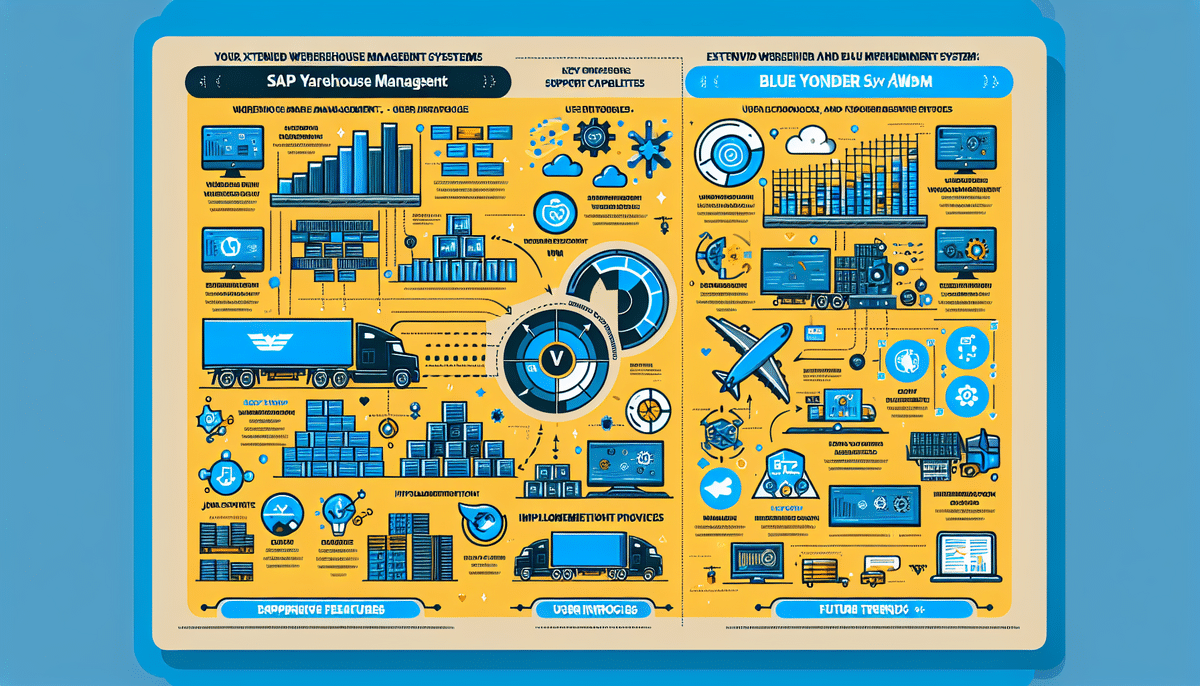Overview of SAP Extended Warehouse Management (EWM) and Blue Yonder WMS
Warehouse management software is essential for optimizing warehouse operations, ensuring efficiency, accuracy, and scalability. Two leading solutions in the market are SAP Extended Warehouse Management (EWM) and Blue Yonder WMS (formerly JDA Software). Both offer comprehensive functionalities tailored to manage various aspects of warehouse operations, but they cater to different business needs and scales. Understanding their core differences and strengths is crucial for businesses seeking to implement an effective warehouse management system.
Key Features and Functionalities
Features of SAP EWM
SAP EWM is an end-to-end solution designed to manage all warehouse operations within a broader supply chain framework. Key features include:
- Inbound and Outbound Logistics: Handles receipt, putaway, and outbound delivery processes efficiently.
- Advanced Inventory Management: Real-time tracking and integration with barcode scanning devices.
- Picking and Packing Optimization: Includes wave management and cartonization to streamline order fulfillment.
- Cross-Docking Operations: Facilitates the transfer of goods from inbound to outbound processes without storage.
- Labor Management: Enhances productivity through task interleaving and resource optimization.
- Seamless Integration: Integrates with other SAP modules like SAP ERP and SAP TM for comprehensive supply chain visibility.
According to SAP's official website, EWM offers robust customization capabilities, making it suitable for industries with complex warehouse requirements.
Features of Blue Yonder WMS
Blue Yonder WMS provides a robust system for inventory management, order fulfillment, and transportation management. Key features include:
- Advanced Analytics and Reporting: Offers deep insights into warehouse operations to identify areas for improvement.
- User-Friendly Interface: Intuitive design with customizable workflows for ease of use.
- Integration Capabilities: Connects seamlessly with ERP and CRM systems to ensure cohesive operations.
- Automation Technologies: Incorporates robotic process automation (RPA) and machine learning to streamline processes.
- Scalability: Suitable for small to mid-sized businesses with adaptable features.
As highlighted in the Blue Yonder website, their WMS is designed to leverage the latest technologies to enhance warehouse efficiency and accuracy.
Pricing and Scalability
Pricing Models
Both SAP EWM and Blue Yonder WMS operate on licensing models, but their pricing structures differ:
- SAP EWM: Pricing is based on factors such as the number of users, required features, and customization needs. It tends to be higher due to its extensive feature set.
- Blue Yonder WMS: Generally less expensive upfront, with costs varying based on user count and feature requirements. Additional fees may apply for certain customizations.
Businesses should assess their budget and required functionalities to determine the most cost-effective solution.
Scalability Comparison
Both systems are highly scalable, but they cater to different organizational sizes:
- SAP EWM: Ideal for large enterprises with complex supply chain and warehouse management needs. Its advanced customization capabilities allow it to handle vast and intricate operations.
- Blue Yonder WMS: Suited for small to mid-sized businesses seeking flexibility without the complexity. It offers scalability that supports business growth without significant infrastructure changes.
According to Gartner's Magic Quadrant, both solutions are leaders in their respective categories, providing reliable scalability options.
Integration and Usability
Integration Capabilities
Integration with existing business systems is critical for seamless operations:
- SAP EWM: Excels in integrating with other SAP solutions like SAP ERP and SAP TM, offering comprehensive supply chain visibility.
- Blue Yonder WMS: Features an open architecture platform that allows integration with various third-party systems, including ERP and CRM software.
Effective integration reduces the risk of errors and enhances operational efficiency.
Ease of Use and User Interface
User experience is a significant factor in system adoption:
- Blue Yonder WMS: Known for its highly intuitive and user-friendly interface, making it easier for employees and managers to navigate and utilize effectively.
- SAP EWM: While powerful, its interface can be more complex due to the extensive functionalities and customization options available.
Businesses should consider the technical proficiency of their staff when choosing between the two.
Support, Implementation, and Case Studies
Support and Customer Service
Both SAP and Blue Yonder offer robust support options:
- SAP EWM: Provides online documentation, customer forums, and dedicated technical support to assist with any issues.
- Blue Yonder WMS: Offers comprehensive customer support along with expert consulting services to optimize warehouse operations.
Implementation Process
The implementation timeline varies between the two:
- SAP EWM: Due to its advanced features and customization capabilities, implementation can be time-consuming, often requiring a detailed project plan and significant resources.
- Blue Yonder WMS: Features a more streamlined implementation process thanks to its open architecture, allowing for quicker setup and integration.
According to industry reports, businesses should allocate sufficient time and resources to ensure a smooth implementation process for either system.
Real-World Case Studies
Numerous companies have successfully implemented SAP EWM and Blue Yonder WMS to enhance their warehouse operations:
- Retail Chain with SAP EWM: A major retail chain integrated SAP EWM to improve visibility and control over their logistics, resulting in increased efficiency and cost reductions.
- E-commerce Retailer with Blue Yonder WMS: A leading e-commerce company adopted Blue Yonder WMS to manage inventory and expedite order fulfillment, boosting customer satisfaction.
- Global Manufacturer with Both Systems: A multinational manufacturing firm implemented both SAP EWM and Blue Yonder WMS to streamline operations and enhance inventory accuracy, leading to improved production planning and reduced lead times.
These case studies demonstrate the adaptability and effectiveness of both systems in diverse operational contexts.
Future Trends in Warehouse Management Software
Emerging Technologies
The warehouse management landscape is evolving with the introduction of new technologies:
- Artificial Intelligence and Machine Learning: Enhancing forecasting, inventory management, and automation processes.
- Internet of Things (IoT): Facilitating real-time inventory tracking, equipment monitoring, and optimizing warehouse layouts.
- Cloud-Based Solutions: Offering flexibility, scalability, and reduced infrastructure costs.
Both SAP EWM and Blue Yonder WMS are incorporating these technologies to stay competitive:
- SAP EWM: Integrates with IoT platforms like SAP Leonardo to leverage real-time data insights.
- Blue Yonder WMS: Partners with IoT device manufacturers to provide comprehensive real-time data analytics.
Adapting to the Changing Landscape
To remain relevant, both SAP and Blue Yonder are continuously updating their offerings:
- SAP EWM: Regularly releases updates that include new features, security enhancements, and integration capabilities to support evolving business needs.
- Blue Yonder WMS: Focuses on expanding its automation and analytics features, ensuring that businesses can leverage the latest advancements in warehouse management.
Staying updated with these trends is crucial for businesses to maintain competitive advantage and operational excellence.
Conclusion
Both SAP EWM and Blue Yonder WMS offer robust functionalities for managing warehouse operations, each with its unique strengths. SAP EWM is ideal for larger organizations requiring comprehensive features and deep integration within the SAP ecosystem. In contrast, Blue Yonder WMS is suitable for small to mid-sized businesses seeking flexibility, ease of use, and advanced analytics. By evaluating factors such as pricing, scalability, integration capabilities, and support options, businesses can determine which solution best aligns with their strategic goals and operational requirements.






















